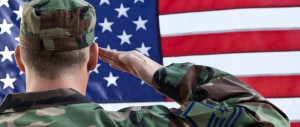Memorial Day is more than just the unofficial kick-off to summer, the Indianapolis 500 and backyard barbeques. It’s a time to remember the men and women who sacrificed their lives for their country.
Originally known as Decoration Day, Memorial Day’s roots can be traced back to the years following the Civil War. It became an official federal holiday in 1971. Many Americans observe Memorial Day by visiting cemeteries or memorials, participating in parades or holding family gatherings
Here’s something to ponder this Memorial Day: According to the Department of Veterans Affairs (VA), there are approximately 19 million veterans. Of that figure, there are about 240,000 World War II veterans still alive. For the Korean War, there are 2. 25 million veterans still alive and 850,000 veterans of the Vietnam War. The youngest Vietnam veterans are now 60 years old.
You may personally know a veteran. He could be your next-door neighbor who dropped in casual conversation that he served in the Marines in Korea. For the last half-dozen years, he’s lived by himself, since his wife passed away. He might’ve slowed down, but he’s still able to take care of himself in his own home. He still goes to the grocery and cuts his own yard once a week. The last thought on his mind is moving into an assisted living community or long-term care facility.
But in the last few months, you’ve noticed subtle changes with your neighbor. You pick up on these changes from the regular over-the-fence conversations you have.
Even though he wouldn’t admit it, publicly or privately, your neighbor could use a little help at home, like someone to remind him to take his daily medication and maybe help cooking meals.
A friend makes you aware of the VA’s Aid and Attendance program. His own father benefits from Aid and Attendance. You’re unfamiliar with it, but start to investigate for your neighbor.
For more than 30 years, Aid and Attendance has financially helped seniors stay at home longer, receive services at home, and even help pay for some of the costs of assisted living.
Aid and Attendance is a special monthly needs-based program available to wartime veterans or surviving spouses. It is not a stand-alone benefit; it’s an additional allowance that a veteran or surviving spouse may be entitled to because of his or her wartime service and non-service-connected disability, if certain medical and financial requirements are met.
Approximately one out of four seniors could qualify for the Aid and Attendance Benefit under the right conditions. What are those conditions?
- The veteran served at least 90 days of active military duty, one day of which was during a war-time period.
- The veteran was honorably discharged from the service. When applying for this benefit, the applicant would be asked to show his discharge papers, the DD-214.
- Must require the assistance of another person to perform some of the activities of daily living (ADLs). The ADLs are eating, bathing, toileting, dressing, and transferring (walking).
- Meet the income and countable asset criteria established by the VA.
- Must be 65 years and older or totally disabled.
The dates of military service determined by the VA are as follows:
- World War II: Dec. 7, 1941 – Dec. 31, 1946
- Korean War: June 27, 1950 – Jan. 31, 1955
- Vietnam War: Feb. 28, 1961 – May 7, 1975
- Persian Gulf War: Aug. 2, 1990 – present
To qualify, your loved one didn’t have to be involved in combat, or even in the theatre of operations. For example, your neighbor served during in the Marines in Korea, but Uncle Bob was an Air Force mechanic stationed in Germany during the Vietnam War. Under the guidelines created by the VA, both your neighbor and Uncle Bob could qualify.
What can Aid and Attendance funds be spent on? Someone to prepare meals, make sure he’s taking his medication, etc… There are licensed agencies in your communities who could provide personnel (a nurse or a sitter, for example) to check in on grandpa a couple of days a week. Aid and Attendance money could be used to help offset that cost.
It’s common practice for family members to lend a helping hand. Not much is thought of it because it’s family and they’re not paid for running errands or doing laundry. The Aid and Attendance funds could be used to pay someone for those tasks and chores. A legal document called a Personal Services Contract (PSC) would be required. A PSC is a contract drawn up by an attorney that outlines services between an employer (person receiving VA benefits), with an employee (another family member or close friend.) An hourly fee is established. The employee, whoever it may be, keeps a log to show what services were done and for how long.
A lot of people will prejudge his or her situation and think they wouldn’t qualify for Aid and Attendance benefits because they have too much money. Qualified financial and estate planners in your area know how to protect assets and get folks approved for Aid and Attendance Benefits on a regular basis.
Filing for Aid and Attendance is a lot like filing for Medicaid: it’s complicated. People make the mistake of trying to apply for the benefit on their own and make mistakes in the application process. The slightest mistake will disqualify you for up to a year. Seek professional help if you’re considering applying for the Aid and Attendance Benefit.
Once your application is submitted, it will take time before you’re approved. It could take six months or longer before you’re approved to receive Aid and Attendance. But don’t worry: once approved, the benefit is retroactive to the application date. So, if you applied on June 1, 2021, but were not approved until Dec. 1, 2021, your first benefits check would be for six months worth of benefits. The following month would contain the regularly monthly amount.
Elder Advisers® is not a law firm or a substitute for an attorney. We offer financial advice. We can work closely with your existing tax and legal advisors or introduce you to those we routinely work with. Nothing in this newsletter is intended as tax advice, a solicitation for insurance, or legal advice, and is merely provided as general information, and should not be relied upon for anyone’s specific or unique circumstances. Some content of this newsletter may have been developed by third party sources not affiliated with Elder Advisers®. If you would like to discuss your situation, we are delighted to help. CALL (800) 763-7930.



